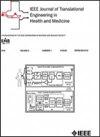层流喷射嗅觉给药:概念验证研究
IF 4.4
3区 医学
Q2 ENGINEERING, BIOMEDICAL
IEEE Journal of Translational Engineering in Health and Medicine-Jtehm
Pub Date : 2024-11-20
DOI:10.1109/JTEHM.2024.3503498
引用次数: 0
摘要
局灶性鼻内给药到嗅裂是一种有前途的途径,药物靶向大脑。然而,传统的鼻腔喷雾剂往往不能将足够的药物输送到这个特定的区域。我们提出了一种层流喷射(LFE)方法,用于精确地向嗅觉腭裂输送药物。使用3d打印的鼻道模型,我们确定了在嗅裂处沉积液体所需的精确插入速度和角度。然后,我们进行了三个概念验证的体内成像研究,以确认嗅觉在人类中的传递。首先,我们使用锝-99(一种放射性标记的示踪剂)和亚甲基蓝(一种实验室制造的染料)来观察嗅觉沉积。两种示踪剂均显示沉积成功。在另一项研究中,我们使用功能磁共振成像(fMRI)来比较我们的LFE方法与传统的鼻腔喷雾剂在给胰岛素时的效果。从功能磁共振成像结果来看,我们定性地观察到胰岛素注射后前额叶皮层脑活动的局灶性下降。总的来说,这些初步结果表明,LFE为嗅觉药物输送提供了一种有针对性的方法,为进入大脑提供了机会。临床和转化影响声明-嗅觉裂的局灶性沉积是将药物输送到大脑的一个有希望的目标。我们提出了一种层流喷射方法用于鼻内给药的人体试验,并证明了比传统鼻腔喷雾剂的改进。本文章由计算机程序翻译,如有差异,请以英文原文为准。
Laminar Fluid Ejection for Olfactory Drug Delivery: A Proof of Concept Study
Focal intranasal drug delivery to the olfactory cleft is a promising avenue for pharmaceuticals targeting the brain. However, traditional nasal sprays often fail to deliver enough medication to this specific area. We present a laminar fluid ejection (LFE) method for precise delivery of medications to the olfactory cleft. Using a 3D-printed model of the nasal passages, we determined the precise velocity and angle of insertion needed to deposit fluid at the olfactory cleft. Then, we conducted three proof-of-concept in-vivo imaging studies to confirm olfactory delivery in humans. First, we used Technetium-99 (a radiolabeled tracer) and methylene blue (a laboratory-made dye) to visualize olfactory deposition. Both tracers showed successful deposition. In a separate study, we used functional MRI (fMRI), to compare our LFE method with a conventional nasal spray while delivering insulin. From the fMRI results, we qualitatively observed focal decreases in brain activity in prefrontal cortex following insulin delivery. Overall, these preliminary results suggest that LFE offers a targeted approach to olfactory drug delivery, opening opportunities for access to the brain.Clinical and Translational Impact Statement - Focal deposition at the olfactory cleft is a promising target for delivering medication to the brain. We present in-human tests of a laminar fluid ejection method for intranasal drug delivery and demonstrate improvements over conventional nasal spray.
求助全文
通过发布文献求助,成功后即可免费获取论文全文。
去求助
来源期刊

IEEE Journal of Translational Engineering in Health and Medicine-Jtehm
Engineering-Biomedical Engineering
CiteScore
7.40
自引率
2.90%
发文量
65
审稿时长
27 weeks
期刊介绍:
The IEEE Journal of Translational Engineering in Health and Medicine is an open access product that bridges the engineering and clinical worlds, focusing on detailed descriptions of advanced technical solutions to a clinical need along with clinical results and healthcare relevance. The journal provides a platform for state-of-the-art technology directions in the interdisciplinary field of biomedical engineering, embracing engineering, life sciences and medicine. A unique aspect of the journal is its ability to foster a collaboration between physicians and engineers for presenting broad and compelling real world technological and engineering solutions that can be implemented in the interest of improving quality of patient care and treatment outcomes, thereby reducing costs and improving efficiency. The journal provides an active forum for clinical research and relevant state-of the-art technology for members of all the IEEE societies that have an interest in biomedical engineering as well as reaching out directly to physicians and the medical community through the American Medical Association (AMA) and other clinical societies. The scope of the journal includes, but is not limited, to topics on: Medical devices, healthcare delivery systems, global healthcare initiatives, and ICT based services; Technological relevance to healthcare cost reduction; Technology affecting healthcare management, decision-making, and policy; Advanced technical work that is applied to solving specific clinical needs.
 求助内容:
求助内容: 应助结果提醒方式:
应助结果提醒方式:


